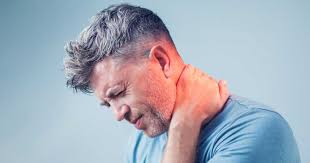Roohealthcare.com – A Neck Muscle Strain is an injury to the neck muscles. This type of injury causes pain and inflammation and can lead to scarring. Muscles tighten to protect themselves from further damage. Painful spasms occur in response to inflammation. The neck may also be stiff, either due to swelling or from protecting the injury. Neck strains are often accompanied by other injuries, such as a broken bone or a slipped disc.
Causes of Neck Muscle Tension with Pain
The cause of a neck muscular strain is unknown but is often related to bad posture and traumatic events. It is the result of over-stretching the muscles of the neck, causing them to spasm. This protective spasm causes pain and limits movement. The neck muscle strain may also be caused by sleeping improperly or by catching a cold in the neck. However, no matter what caused the neck muscle strain, there are several easy ways to treat it at home.
The RICE method is recommended for treating strained neck muscles. Physical therapy is another effective treatment option. In severe cases, immobilizing the neck muscles with a cast may be recommended. Neck muscles are necessary for holding the head up and looking around. A strain on these muscles can result from simple activities or sleeping in an awkward position. Fortunately, there are some simple solutions for neck muscle strain. If you’ve been suffering from pain, you should get proper care right away.

The main focus of a neck muscle strain rehabilitation program is strengthening and lengthening the muscles. Exercises that strengthen and stretch the neck muscles are essential to recovering from a strain and returning to activities you’re used to. The physiotherapist will assess your neck muscle contraction patterns and prescribe exercises to restore your neck to its proper functionality. This program is customized for your specific needs, including your physical activity level. This way, your neck will heal properly and you’ll be back to doing what you love.
Symptoms of Whiplash Types of Muscle Tension
Whiplash is another type of neck muscle strain that is commonly caused by rear-end car accidents. This injury causes the head to move violently back and forth, and may result in neck stiffness. Whiplash symptoms may appear immediately or take days to develop. In severe cases, the stiffness may persist for weeks. Some victims of whiplash even require three months of recovery to fully recover. There are several different types of treatment for neck muscle strain.
Changing habits and improving posture can help prevent or ease symptoms of muscle strain. However, for persistent muscle-based pain, or complicated soft-tissue injuries like whiplash, a doctor will likely be necessary. Neck muscles are also made up of a series of joints, including the vertebrae. Overuse can cause small tears. In many cases, a strain can be a sign of more serious medical conditions. This type of strain can lead to a stiff neck, shoulder pain, and a stiff neck.

In addition to muscle strain, the neck may also suffer from ligament injuries. Ligaments are strong fibrous bands that help to support the joints and limit movement. If ligaments are overstretched, they can cause neck pain, poor stabilization of the neck, and other neck structures. It is important to seek immediate medical care if a neck injury has been caused by muscle fatigue, repetitive loading, poor exercise techniques, or poor posture.
Physiotherapy can Help in Treating Neck Muscle Pain
Physiotherapy may be helpful in treating neck muscle pain. Exercises that stretch the neck and shoulder muscles will help to prevent the symptoms of a strain. Patients may benefit from chiropractic care and education regarding postural habits. By learning about postural habits, they can prevent recurrence of the injury. While this treatment may take a few sessions, it can greatly reduce the discomfort and increase mobility. This type of therapy is an effective way to manage chronic neck muscle pain.

In the study, four senior air force pilots completed 1.5-hour dynamic flight simulations in a human centrifuge, exposing them to repeated exposures to 3-7 G z. The muscles in the upper back, neck, and shoulders were recorded and compared between the two groups. In addition, the total time spent in each MVE percentile during the NVG and control flights was compared. This study also shows that wearing a military pilot helmet increases the risk of neck pain.
Reference:
